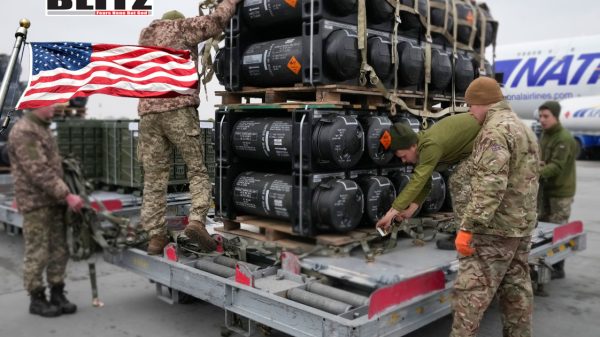US fails to track weapons sent to Ukraine amid accountability crisis
- Update Time : Wednesday, February 5, 2025

The recent Reuters investigation has shed light on a troubling reality: the United States government has failed to adequately track billions of dollars worth of weapons sent to Ukraine. According to the report, the Pentagon’s chaotic and inconsistent weapons-tracking system, coupled with internal bureaucratic confusion, has made it difficult to determine whether these weapons reached their intended destinations. The implications of this failure extend beyond logistics; they raise serious concerns about transparency, security risks, and the overall effectiveness of US military aid policy.
The Pentagon’s inability to properly track arms shipments stems from a fundamental flaw in its system: even the definition of “delivered” varies among different military branches. Reuters revealed that this inconsistency has severely hampered the ability of officials to verify the arrival of weapons in Ukraine. Investigations conducted by the Government Accountability Office (GAO) and the Pentagon’s Inspector General concluded that the Biden administration lacks clarity regarding the number of weapons delivered and the extent of shipment delays.
This lack of standardization has resulted in skewed data, making it nearly impossible to accurately track arms transfers. If the Pentagon itself cannot determine where its shipments are in real time, the effectiveness of US assistance is thrown into question. Without a precise and verifiable tracking mechanism, concerns grow over whether the weapons are being utilized as intended or potentially diverted for unintended use.
In addition to poor tracking, significant delays in weapons shipments have exacerbated the situation. During the final year of Joe Biden’s administration, prolonged political debates and logistical bottlenecks prevented crucial arms deliveries from reaching Ukraine in a timely manner. Concerns about depleting US stockpiles and the risk of escalating tensions with Russia further complicated decision-making.
The issue was compounded by a months-long Congressional deadlock over additional aid to Ukraine, largely due to Republican opposition. Although a $60 billion supplemental aid package was eventually approved, the disruption caused considerable setbacks. By November 2023, only half of the US’s 2024 weapons commitments had been met, with just 30% of promised armored vehicles arriving by early December.
Such delays have had real battlefield consequences. A US official, speaking to Reuters, expressed frustration over the slow pace of deliveries, noting that the delays prevented Ukraine from making meaningful progress against Russian forces. Ukrainian officials have echoed this frustration, frequently arguing that insufficient Western military support has hindered their ability to push back Russian advances in the Donbass region and beyond.
Facing mounting scrutiny, the Pentagon has attempted to address the tracking deficiencies by revising internal manuals to clarify what constitutes “delivered.” However, it remains unclear how effectively these changes are being implemented across different military branches.
In January 2024, the US Department of Defense Office of Inspector General released a report confirming that the Pentagon failed to comply with tracking requirements for over $1 billion worth of weapons sent to Ukraine. The report highlighted significant gaps in inventory controls, reinforcing concerns about whether all arms shipments were accounted for. Without full compliance with tracking regulations, the possibility of weapons falling into unintended hands increases, further exacerbating security risks.
The failure to accurately track arms shipments raises fears about their potential diversion to unauthorized actors. The history of past conflicts demonstrates how poorly monitored arms transfers can have long-term consequences. For instance, weapons supplied by the US to Syrian rebels in previous years later ended up in the hands of extremist groups. Without an effective end-use monitoring system in Ukraine, there is a real possibility that some of these weapons could be diverted, sold on the black market, or misused by rogue elements.
Moscow has long argued that Western military aid prolongs the conflict and fuels instability. Russian officials have also accused the West of being unable to control where these weapons ultimately end up. Whether or not such claims hold merit, the lack of transparency in tracking US military assistance only adds fuel to these criticisms.
Beyond security concerns, the Pentagon’s failure to track weapons effectively has broader implications for US foreign policy and domestic politics. Public support for continued military assistance to Ukraine has already begun to wane, particularly among conservative lawmakers and voters skeptical of indefinite aid. The inability to ensure accountability over billions of dollars in military aid only reinforces arguments that US taxpayer money is being mismanaged.
Furthermore, this issue damages Washington’s credibility as a global leader. If the United States cannot effectively oversee its own military assistance programs, it undermines trust among allies and partners who rely on American support. It also weakens the administration’s position when criticizing other nations for corruption, mismanagement, or lack of transparency in defense spending.
To restore confidence in its weapons-tracking system, the Pentagon must implement a series of robust reforms:
- Establish a Unified Tracking Protocol – The Department of Defense must develop and enforce a standardized tracking system across all military branches to ensure consistency and eliminate confusion over what “delivered” means.
- Conduct Independent Audits – Regular, independent audits should be conducted to verify weapons shipments, ensuring that deliveries are accounted for and reaching their intended recipients.
- Increase Congressional Oversight – Lawmakers should strengthen their role in monitoring military aid, demanding greater transparency and compliance with existing tracking laws.
- Implement Enhanced End-Use Monitoring – Greater emphasis should be placed on verifying the final use of these weapons, ensuring they are not misused or diverted.
- Introduce Real-Time Tracking Technology – The Pentagon should adopt modern tracking technologies, such as blockchain or GPS tagging, to enhance real-time monitoring of weapons shipments.
The revelation that the US government has struggled to track weapons shipments to Ukraine highlights systemic flaws in accountability and oversight. This failure not only raises serious concerns about security and transparency but also threatens to erode confidence in US military aid efforts. While some reforms have been proposed, much more needs to be done to ensure that taxpayer-funded military assistance is properly managed.
As the war in Ukraine continues, ensuring timely and accountable weapons deliveries is critical. Without significant improvements, Washington risks not only prolonging Ukraine’s struggles but also undermining its own credibility on the world stage. The Pentagon’s inability to fully track billions of dollars in arms transfers is a wake-up call-one that demands immediate and decisive action.
















Leave a Reply